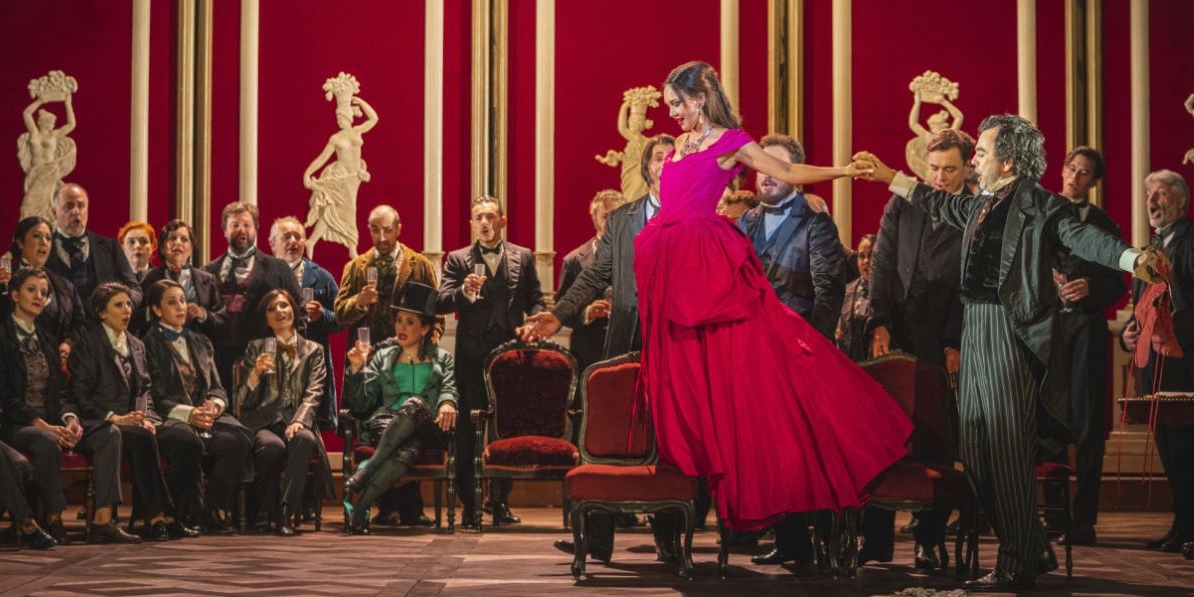Many of Giuseppe Verdi’s operas expose prejudice against social outcasts. Rigoletto – a hunchback, Il Trovatore – gypsies, La Forza del Destino – a mixed-race Inca Prince, and La Traviata – a’ fallen woman’.
The first season of new Opera Director Cecilia Bartoli, has been challenging due to two major last- minute cancellations, last month, and this month with Placido Domingo withdrawing for ‘personal reasons’. It is a tribute to Bartoli’s knowledge and resourcefulness that she found excellent replacements.
Grinda’s production, first seen in 2013 in Saint-Étienne respects the historical context; the décor and costumes are of the era of Napoleon III. The lighting emphasised darkness and light.
The overture is a resume of the opera backwards beginning with the music heard at the beginning of Act III when Violetta is dying ending with the party music of Act I following immediately after the overture. Grinda’s production gives a back story to the overture. Violetta is in a brothel, very sick. Baron Duphol falls in love with Violetta, buys her from the brothel and takes her home. The back of the set draws away to reveal Duphol’s residence, but the bed is left by the side of the stage as a constant reminder that Violetta will die there.
Grinda’s production is inspired, despite some oddities. Why are the women chorus in Act I dressed as men? The gypsy chorus choreography in Act II Sc 2 is offensive and against the spirit of the music. One female ballet dancer being abused by men dressed as toreadors makes unpleasant viewing.
Conductor Massimo Zanetti delivered a sensitive, dramatic reading of the score.
Russian soprano Aida Garifullina is a beautiful woman with a stunning figure, who could be a model if she gives up the day job. She was fired from Metropolitan Opera for singing Violetta in Moscow after the Russian invasion of Ukraine. She was the last person to sing a concert with the late great Dmitry Hvorostovsky three months before he died.
She sang powerfully, but does not have the floated pianissimo fil di voce at the top of the voice essential for Violetta.
Verdi composed Act III meticulously to portray a weak, dying woman; every effort and painful spasm is clear from the music. Garifullina is the healthiest dying Violetta I have ever seen, striding instead of dragging herself to the mirror for ‘come son mutata’ – how I have changed. In ‘addio del passato’, the end of both verses on ‘tutto fini’ the score is marked ‘fil di voce’. Garifullina sings pianissimo, but instead of the fil di voce floating away to nothing, it crescendoes to forte. Garifullina does not sing what Verdi wrote.
With a final surge of strength, Violetta should sing ‘oh gioia’, dying before finishing the phrase at the beginning of the bar, the horrified observers singing at the end of the bar. Instead Garifullina strides to the back of the stage so no facial expression is visible, collapsing many bars later forcing the orchestra to stop to wait for her! That an artist of this calibre ignores the musical requirements and hardly bothers to act, is perplexing.
Superstar Mexican tenor Javier Camarena is the best Rossini and bel canto specialist of his generation, transitioning effortlessly in his debut in the heavier role of Alfredo; he is vocally and dramatically perfect, a good actor and a joy to hear. His legato line and radiant tone in un di, felice, eterea was spellbinding.
Italian baritone Massimo Cavaletti as Germont is a refreshing discovery (he usually sings in Zurich). Most Germonts are won over by Violetta, but not Cavaletti’s – he retreats, disgusted when she asks to be embraced as a daughter, refusing to be deflected from his mission to break up Violetta and Alfredo. He has a rich, robust voice singing ‘di provenza’ with good legato lines and a lovely honeyed tone, although I prefer two breaths in the first four phrases instead of three (Hvorostovsky did it in one, but his breath control was legendary).
Mezzo Lauriana Castellano is impressive as Flora. All three main soloists received ecstatic applause.
Medici TV is broadcasting this on 30th March 2023. It is well worth seeing.

